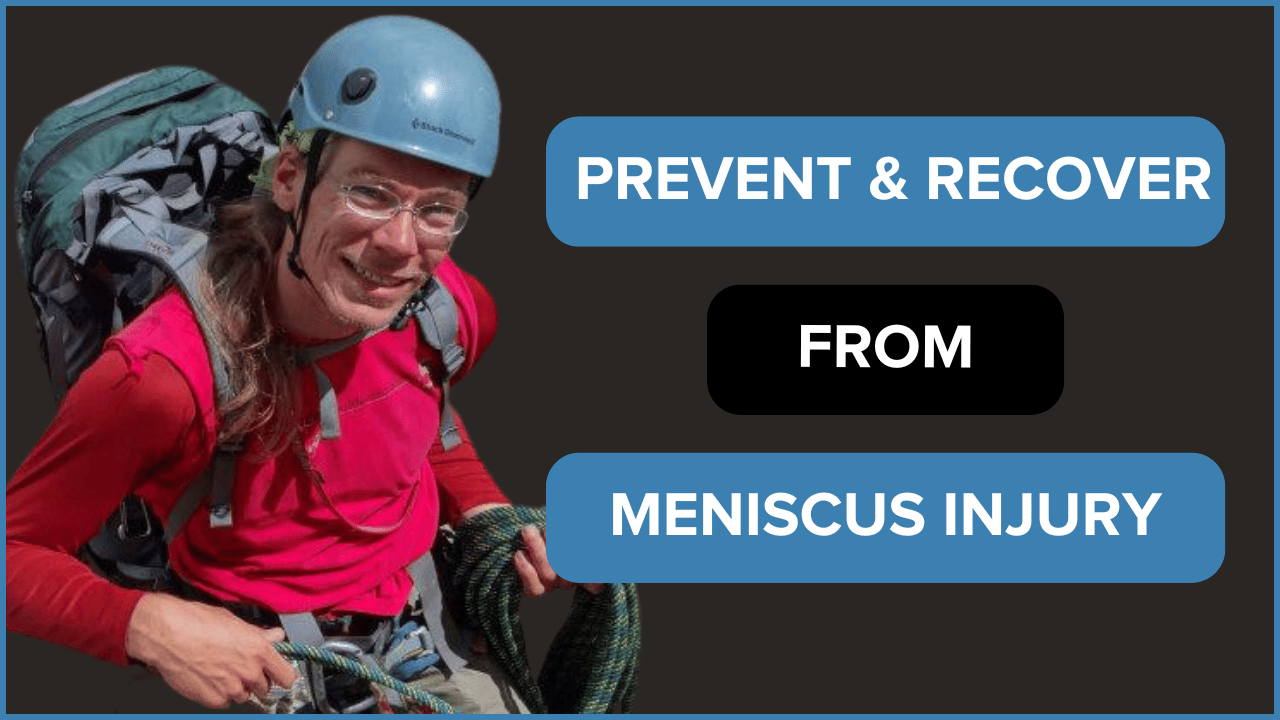S2, E2: DIP Joint Finger Pain – Steve Smith
This interview focuses on discussing DIP joint pain in climbers. Steve Smith, a doctor of physical therapy, explains the anatomy of the finger and the specific joints involved in DIP joint pain. Steve highlights the causes and symptoms of this type of injury, emphasizing the importance of understanding the mechanics of climbing and the impact on the joints. He also provides insights into the rehabilitation process, including rest, joint mobility work, and dynamic warm-up exercises. Steve discusses the role of other factors such as wrist position and technique in contributing to DIP joint pain. He concludes by recommending exercises to strengthen finger and wrist extensors, as well as pinch grip variations. In this conversation, Jared Vagy and Steve discuss hangboard recommendations, returning to climbing after an injury, and final thoughts on the diagnosis of DIP synovitis capsulitis.
Steve’s Bio
Steve Smith is a Doctor of Physical Therapy, who is a board certified specialist in Orthopaedic Physical Therapy, and Strength & Conditioning. He has been climbing since 2006, and has a particular interest in specialized sport training and rehabilitation, using science and evidence-based practice to improve performance and return patients to their highest level of athletic abilities. Steve works in an academic Orthopedic and Sports Medicine setting and, in his free time, acts as a training and injury risk reduction consultant to local competitive and recreational climbers. He currently lives in Huntington, WV with his wife, son and daughter.
Takeaways
- DIP joint pain is a common injury in climbers, often caused by overuse and excessive stress on the joint.
- Understanding the anatomy of the finger and the mechanics of climbing can help prevent and manage DIP joint pain.
- Rehabilitation for DIP joint pain involves rest, joint mobility work, and dynamic warm-up exercises.
- Strengthening finger and wrist extensors, as well as varying grip positions, can help prevent and alleviate DIP joint pain. When it comes to hangboarding or climbing with an injury, it’s important to find an entry point and modify the routine to avoid exacerbating the injury.
- Returning to climbing after an injury can be done by modifying the intensity and volume of climbing, focusing on slab climbing or easier holds, and monitoring symptoms.
- Managing DIP synovitis capsulitis requires finding the right dosage of training that allows progression without flaring up the injury.
Seeking the guidance of a physical therapist or coach can help with individualizing the fingerboard program and ensuring proper rehabilitation.
Listen on Apple Podcasts, Spotify, or wherever you listen to podcasts!
Timecodes
-
00:00 Introduction and Background
-
03:10 Understanding DIP Joint Anatomy and Injury
-
05:34 Increase in Joint-Related Injuries in Climbers
-
07:35 Causes and Symptoms of DIP Joint Pain
-
16:19 Rehabilitation Process for DIP Joint Pain
-
25:05 Importance of Varying Grip Positions
-
28:40 Other Factors Contributing to DIP Joint Pain
-
33:00 Exercises for Strengthening Finger and Wrist Extensors
-
38:03 Pinch Grip Variations
-
42:08 Hangboard Recommendations
-
46:11 Returning to Climbing
-
48:30 Final Thoughts on DIP Synovitis Capsulitis Diagnosis
If you would like to listen to the entire interview with Steve, check out the podcast. If you want to watch the interview, click the YouTube link or any of the timestamps above. If you would like to read quick sample of the interview, check out the excerpt from the interview below.
Let’s break it down. Tell us about yourself and the topic we’re going over, which is DIP joint pain. You’ve written an article on this, so introduce yourself to those who may not know you.
My name is Steve Smith. I’m a doctor of physical therapy with orthopedic and strength and conditioning certifications. PT is a second career for me. I started with a bachelor’s degree in marketing and sales management but later pursued physical therapy.
That’s quite a career change. You were a dirt bag climber before, right?
Yes, I was, traveling around and climbing, even selling plasma to make rent. Then I decided to go back to school for physical therapy.
Impressive! How long have you been a physical therapist?
It’s almost been 10 years now.
Let’s dive into the topic of DIP joint pain. Can you explain the anatomy of the finger and what this injury entails?
Certainly, the DIP (Distal Interphalangeal) joint is essentially our initial point of contact with the rock. In this article, I wanted to address an injury I’ve personally experienced. Often, climbers focus heavily on finger flexors but overlook the other side of the finger, the DIP joint. It’s where the distal phalanx meets the middle phalanx, surrounded by ligaments, joint capsules, and muscles. Specifically, we’ll focus on the flexor digitorum superficialis and flexor digitorum profundus tendons. The profundus runs under the superficialis and crosses the DIP joint, which raises questions about the forces it endures during full crimp positions.
There’s been a noticeable shift towards joint-related injuries in climbers, particularly in the PIP (Proximal Interphalangeal) and DIP joints. The continuous gripping of holds, especially in the full crimp position, hyperextends the DIP joint and hyperflexes the PIP joint, leading to localized stress. Climbing stresses these joints when fingers are twisted into tight spots, such as crack climbing, or during frequent crimp usage. Microtrauma ensues, triggering inflammation, thickening of synovial fluid, chronic inflammation, joint thickening, arthritis, and bone spurs. This cycle often results in those familiar gnarly fingers we see in experienced climbers.
What’s the rehab process for DIP capsulitis, and what should climbers expect when they see a physical therapist?
When addressing DIP capsulitis, it’s crucial to recognize the symptoms, such as decreased mobility and finger pain in the last joint due to excessive crimping. Climbers should anticipate a multi-faceted rehab approach. Firstly, in the acute phase, it’s essential to unload the affected area, employing methods like ice application, relative rest, and anti-inflammatories to reduce swelling. Additionally, incorporating gentle massage techniques can help alleviate some of the swelling.
Furthermore, we recommend introducing joint mobility work, both passively and actively. However, it’s vital to exercise caution during this phase, especially avoiding any movements that involve extending the affected joint, as this might exacerbate the issue.
As part of this joint mobility work, climbers can isolate the specific joint, typically with the thumb and index finger of their opposite hand, and perform controlled back-and-forth movements to maintain some level of active mobility while also focusing on the joint itself. This aids in keeping the joint lubricated and helps prevent further stiffness.
Can you explain why the ring finger is different from the pointer finger, and what predisposing factors should be considered?
Certainly. The distinction between the ring finger and the pointer finger lies in their anatomy and the range of motion they offer. The ring finger, due to its structure and location, possesses less mobility compared to the pointer finger, particularly when attempting to hyperextend it or push it backward.
In terms of predisposing factors, climbers should be aware that DIP capsulitis is more likely to affect newer climbers who rely heavily on the full crimp position without fully understanding the mechanics involved. These individuals may not have started hangboarding or focusing on climbing technique, which can increase the risk of this injury.
Additionally, those who rapidly intensify their climbing routines or engage in routes that require extensive use of the full crimp position, particularly advanced climbers, are also susceptible to developing this type of injury.
Discuss the importance of long-term injury reduction and incorporating a dynamic warmup into climbers’ routines.
Long-term injury reduction is a critical aspect of climbers’ training and should be integrated into their routines. Following the acute phase of DIP capsulitis rehabilitation, climbers should focus on preventing future injuries.
One essential component of this is incorporating a comprehensive dynamic warmup into their climbing routine. A dynamic warmup serves to enhance blood circulation, prepare the muscles and joints for activity, and optimize overall performance.
While static stretching has been traditionally popular, recent research suggests that it may not effectively warm up the muscles or contribute significantly to injury prevention. Thus, it is recommended to perform static stretching separate from climbing activity.
For climbers, a dynamic warmup should be specific to the demands of climbing, emphasizing finger and wrist extensor strength to create a balanced grip. This can involve exercises like tendon glides, ball squeezes, and rice bucket drills, which target finger and wrist extensors, enhancing the overall strength and stability of the hand.
The dynamic warmup should ideally be integrated into the climber’s routine before exercise, hangboarding, or climbing sessions. It’s worth noting that a dynamic warmup can also become part of regular maintenance, ensuring that climbers are adequately prepared and resilient to the demands of their sport.
Sure, here’s the Q&A format with Jared’s questions shortened to one sentence and Steve’s responses lengthened:
Pinch grip variations and wrist extension exercises—could you discuss these in detail?
Certainly, let’s dive into pinch grip variations and wrist extension exercises. Pinch grip variations can be particularly useful for strengthening finger flexors and extensors, but they may put some compression on the outside of the elbow. For wrist extension exercises, they involve having your forearm resting on a bench or similar support with a dumbbell in your hand, allowing controlled wrist movement. This exercise can be especially helpful for climbers dealing with lateral elbow pain or seeking to improve wrist strength and stability.
What are some key considerations when performing wrist extension exercises, especially for climbers dealing with lateral elbow pain?
It’s crucial to maintain the right elbow position, typically bent at around 30 to 60 degrees from straight, to minimize compression on the outer elbow tendon. Start with a weight that challenges you but doesn’t strain excessively, and perform three to four sets of six to 12 repetitions. This exercise can be done using a dumbbell or a kettlebell, but be cautious about using very heavy weights, as it may lead to wrist issues.
Can you explain the differences between isotonic and isometric exercises for finger and wrist extensors?
Certainly, let’s explore the distinctions between isotonic and isometric exercises. Isotonic exercises involve moving a weight, such as a dumbbell, and can be beneficial for building strength and endurance. Isometric exercises, on the other hand, entail pushing or pulling against an immovable force, which can be a valuable approach for rehabilitating or strengthening specific muscle groups without joint motion. There are two types of isometric exercises—yielding and overcoming isometrics. Yielding isometrics involve maintaining a static position against resistance, whereas overcoming isometrics require attempting to move an immovable object. Both types have their place in a climbing-specific training regimen, depending on individual goals and needs.
How should climbers program these exercises effectively, considering factors like tendon density, muscle hypertrophy, and symptom management?
Effective programming depends on individual goals and symptom response. If you’re targeting strength and stiffness, aim for a total time under tension of 30 to 90 seconds, with higher-intensity, shorter-duration holds. For tendon density or muscle hypertrophy, consider extending the time under tension to 80 to 150 seconds per set and incorporating longer holds to reduce intensity. It’s essential to monitor your symptoms and adapt your program accordingly, avoiding overloading the affected area.
You mentioned pinch grip variations—can you elaborate on these, including potential benefits and precautions for climbers?
Certainly, let’s delve deeper into pinch grip variations. These exercises can be a more advanced way to load your finger and wrist extensors. By creating different pinch grip setups, such as using two by fours, knob holds, or even upside-down kettlebells, climbers can target finger flexors, extensors, and wrist muscles while keeping the joint relatively unloaded. However, climbers should be mindful of potential overuse injuries, so it’s advisable to cycle through different variations to prevent strain or injury.
How can climbers adjust their training to avoid overloading their fingers and wrists, especially when dealing with finger pain or discomfort?
When dealing with finger pain or discomfort, it’s essential to find a balance between maintaining strength and avoiding overloading. Climbers can modify their training by reducing volume, intensity, or both, as needed to minimize strain on the affected area. Additionally, monitoring symptoms and using pain as a guide can help climbers determine when to back off or make further adjustments in their training routine.
Could you share insights on incorporating hangboard training for climbers dealing with DIP synovitis capsulitis?
Certainly, hangboard training can be a valuable tool for climbers managing DIP synovitis capsulitis. It’s essential not to completely stop climbing but rather modify your approach. Consider using open-hand positions, larger holds, or slopers to reduce stress on the affected area. Duration and intensity can be adjusted based on your pain threshold and individual needs. However, if you struggle with longer hangs due to other body limitations, consider consulting a physical therapist for personalized guidance.
Returning to climbing after dealing with this condition can be challenging—what recommendations do you have for climbers seeking a safe return?
Returning to climbing should be gradual and considerate of your body’s response. Start by climbing slabs, jugs, or slopers to minimize stress on the affected area. Ensure that your symptoms remain below a four out of ten on the pain scale and avoid exacerbating pain the next day. Evan Ingersen’s article and podcast on returning to climbing offer excellent guidance and should be a valuable resource for climbers making a safe return.
Any final thoughts or advice for climbers dealing with DIP synovitis capsulitis?
In closing, I’d emphasize the importance of early intervention and avoiding prolonged issues. Don’t completely avoid finger flexion positions but do take some time to offload the affected joint initially. It’s crucial to make necessary modifications in your climbing technique to manage symptoms effectively while maintaining strength and resiliency for future climbing challenges. If you have questions or need guidance, please feel free to reach out for support and individualized recommendations.
How can climbers get in touch with you?
Email is the best way. They can email me at: stephen.smith.dpt@gmail.com
- Disclaimer – The content here is designed for information & education purposes only and the content is not intended for medical advice.




